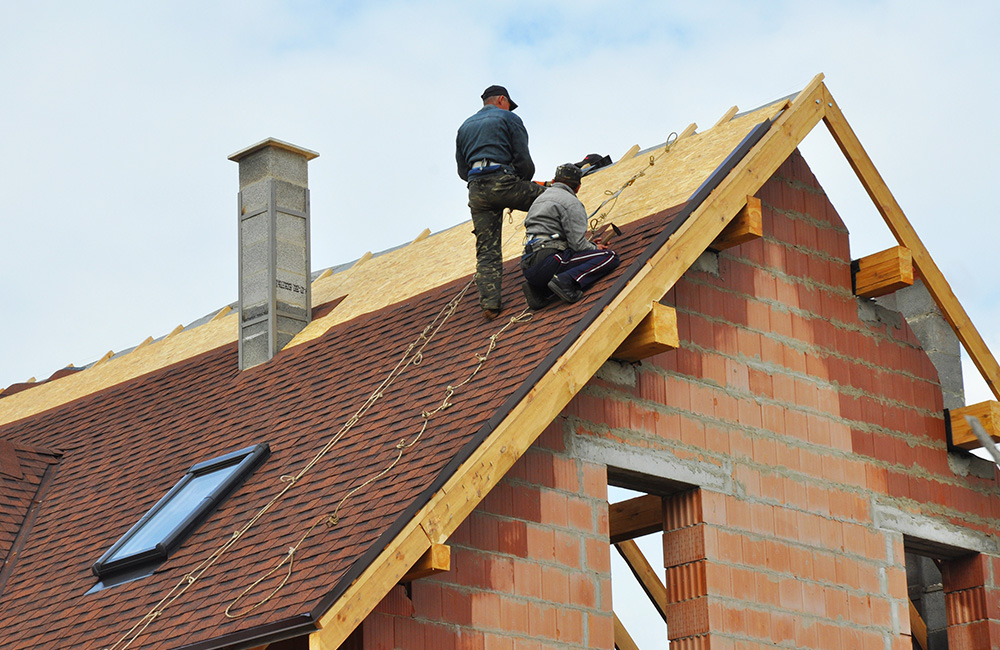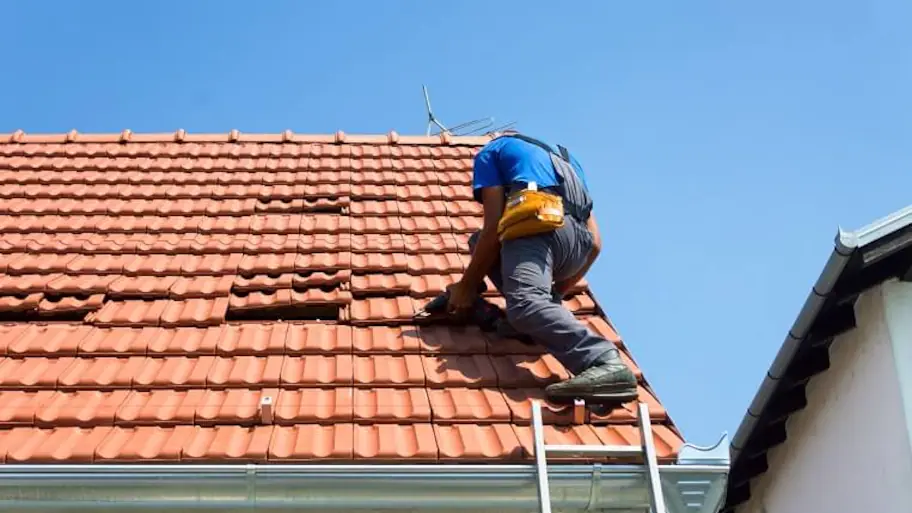Seasonal Roof Covering Repair Checklist: Prepare Your Roofing for each Weather
By complying with a seasonal roofing system repair list, you can remain in advance of prospective issues. Allow's check out how proper maintenance can protect your home and prolong your roof's life-span.
Checking Your Roofing System for Wintertime Readiness
As wintertime methods, it's important to check your roof covering to validate it can stand up to severe weather. Beginning by looking for missing or damaged roof shingles; also a little issue can bring about considerable leakages when snow and ice build up. Next, examine the blinking around vents and chimneys-- this area is usually prone to water invasion.
Do not neglect to search for indicators of sagging or irregular surface areas, as these could show architectural issues. In addition, confirm your seamless gutters are clear; clogged seamless gutters can lead to ice dams that harm your roofing system.
 roof repair
roof repair
Springtime Cleansing: Clearing Particles and Monitoring for Damage
Once winter months's hold releases, it's time to take on spring cleansing on your roofing by removing debris and examining for any type of damages. Beginning by inspecting your roofing system for fallen branches, leaves, and other particles that can catch dampness and cause rot. A clean roof covering advertises far better water drainage and stops mold growth.
Next, get hold of a tough ladder and very carefully inspect roof shingles for fractures or missing pieces. Take notice of areas around smokeshafts and vents, as these spots are susceptible to leaks. Don't fail to remember to analyze your rain gutters, guaranteeing they're devoid of blockages that might result in water merging.
While you're up there, try to find indications of wear, like rust on steel flashing or loosened seals around skylights. If you find any problems, addressing them now can conserve you from costly repairs later. A little springtime cleaning goes a long way in preserving your roofing system's integrity.
Summertime Heat: Examining Your Roofing for Heat-Related Issues
As summer season warm increases, it's important to evaluate your roof covering for heat-related problems. Look for any tile damage, try to find indicators of warmth fastening, and review just how well your roof covering ventilates. Taking these actions currently can avoid bigger issues in the future.
Evaluate for Roof Shingles Damage
 roof repair
roof repair
Inspect for Heat Buckling
Warm buckling is an usual problem that can emerge throughout the scorching summer season, and it's vital to look for it on your roof covering. As temperatures soar, roof covering products, particularly asphalt shingles, can broaden and agreement. This movement can cause warping, creating undesirable lumps or cracks. Begin by examining your roof aesthetically; try to find any kind of unequal surface areas or raised sides. Pay unique focus to areas around chimneys and vents, where buckling is most likely to happen. If you detect any kind of signs of warm buckling, it's vital to resolve them immediately to protect against further damages. If you're uncertain concerning the extent of the issue or exactly how to repair it effectively., think about consulting a specialist.
Evaluate Roof Ventilation Effectiveness
After checking for heat buckling, it's essential to assess your roofing's ventilation performance. Proper ventilation assists manage temperature and moisture, avoiding damages from extreme warmth. Remember, preserving excellent air flow not just prolongs your roofing's life however likewise enhances your home's overall power efficiency, assuring comfort during those warm summer season months.
Rainy Season Preparedness: Ensuring Appropriate Drain
As the wet period techniques, you need to assure your roofing's drainage system prepares to take care of heavy rainstorms. Start by inspecting your gutters and downspouts, and see to it they're clear of particles. Don't neglect to check the blinking and seals to stop leaks and water damages.
Evaluate Gutters and Downspouts
Throughout the rainy period, it is essential to on a regular basis inspect your downspouts and rain gutters to guarantee appropriate water drainage. Start by looking for any noticeable debris, like leaves or twigs, that can obstruct the flow of water. Make certain the gutters are firmly connected and without sagging, as this can trap water and bring about leakages. Next, take a look at the downspouts for obstructions or damages; an obstructed downspout can create water to overflow, potentially damaging your roof covering and foundation. Also, verify that downspouts straight water away from your home's foundation. If you spot any problems, address them immediately to avoid expensive fixings. When hefty rainfalls struck., a little upkeep now can save you big migraines later.
Clean Roof Surface Particles
Use a roof rake or mop to gently remove debris, being mindful not to harm the roof shingles. After cleansing, monitor your roofing after hefty rainfalls to detect any prospective issues early. Maintaining your roofing clear of debris is vital for stopping pricey fixings down the line.
Examine Flashing and Seals
After clearing your roofing system of particles, take a closer look at the blinking and seals around smokeshafts, vents, and skylights. If you see any damage, it's crucial to repair or replace it promptly. Making certain these components are in good problem will certainly aid preserve proper water drainage and shield your home from water damages during heavy rainfall.
Checking and Preserving Roofing System Seals and Flashing
While it might appear very easy to overlook, inspecting and maintaining roofing seals and blinking is essential for avoiding leaks and water damages. If you detect any kind of problems, it's best to reseal them with ideal roofing sealant to ensure a tight fit.
Following, examine the flashing, which routes water away roof repair gainesville ga from crucial locations. Check for rust, loosened sections, or curved sides. Change it or protect it correctly to preserve its stability if you discover any damaged blinking. Remember, also a tiny problem can bring about considerable issues later on.
Lastly, don't neglect to clean off any type of debris that may block the seals or flashing. Maintaining these elements in excellent shape will aid guard your roofing system versus the elements and prolong its life expectancy.
Rain Gutter Upkeep: Maintaining Water Streaming Smoothly
Considering that your seamless gutters play an essential role in routing rain away from your home, normal maintenance is vital for preventing water damage and structure problems. A blocked seamless gutter can lead to water overflow, which might damage your roofing and home siding.
Next, evaluate for any kind of signs of rust, holes, or sagging areas. If you notice any type of damage, repair work or change the affected parts without delay. Verify downspouts are routing water at the very least 6 feet far from your foundation. Think about including expansions if necessary.
Lastly, inspect that your gutters are properly sloped, ideally a quarter inch for each 10 feet. This slope assurances water flows smoothly towards the downspouts. Regular upkeep will certainly keep your rain gutters working successfully and protect your home from costly repairs.
Arranging Professional Evaluations for Comprehensive Treatment
On https://expression-blend.com/ll-roofing-delivering-excellence-in-roofing-solutions-for-gainesville-and-beyond/ a regular basis scheduling professional examinations is vital for preserving your roof's integrity. These experts can spot potential problems prior to they turn into expensive repair work. Aim for at the very least 2 inspections a year-- one in the springtime and another in the fall. This timing permits you to deal with any damages caused by wintertime climate or summer tornados.
Throughout examinations, specialists will certainly assess roof shingles, blinking, and air flow, ensuring whatever's in leading shape. They'll additionally inspect for indications of wear, leaks, or mold, which you may neglect. Arranging these evaluations not just prolongs your roofing system's lifespan but additionally provides you satisfaction.
If you're unclear regarding the problem of your roof covering, don't think twice to call a professional. Spending in these examinations now can save you a lot later on. Prioritize your roofing's health, and you'll be well-prepared for whatever weather condition comes your way.
Frequently Asked Concerns
Exactly how Frequently Should I Check My Roof Throughout the Year?
You should examine your roofing a minimum of two times a year, preferably in springtime and autumn. After extreme weather condition occasions, check for damage too. Routine examinations assist you capture issues early and conserve money on repair work.
What Signs Suggest I Required a Roofing System Substitute Instead of Repair?
 roof repair
roof repair
Can I Perform Roof Repairs Myself, or Should I Hire a Specialist?
You can carry out minor roof repairs yourself if you fit with elevations and standard tools, however hiring an expert assurances safety and security and appropriate work. Don't risk damages; it could be worth the investment for satisfaction.
What Are the very best Materials for Roof Covering Services in Various Environments?
For different climates, you'll want products like asphalt roof shingles for modest areas, metal roof for extremes, and clay floor tiles for hot regions. Always take into consideration regional climate patterns to assure your roofing system stands up to the aspects effectively.
Exactly How Do Roof Covering Warranties Influence Seasonal Upkeep Responsibilities?
Roof covering guarantees commonly specify maintenance obligations, so you'll require to assess the terms. If you do not maintain your roofing as needed, you could nullify the service warranty, leaving you in charge of expensive repairs.
Seasonal Roofing System Repair Work Checklist: Prepare Your Roof Covering for Every Weather
As soon as wintertime's hold releases, it's time to deal with spring cleansing on your roof covering by removing away debris and examining for any damage. Inspect for any type of roof shingles damages, look for indications of heat buckling, and review how well your roof aerates. If you find any kind of problems, think about getting in touch with a specialist for repair services to keep your roof covering in top shape and shield your home from prospective water damages.
While it could seem simple to neglect, inspecting and keeping roofing system seals and flashing is important for preventing leakages and water damage.